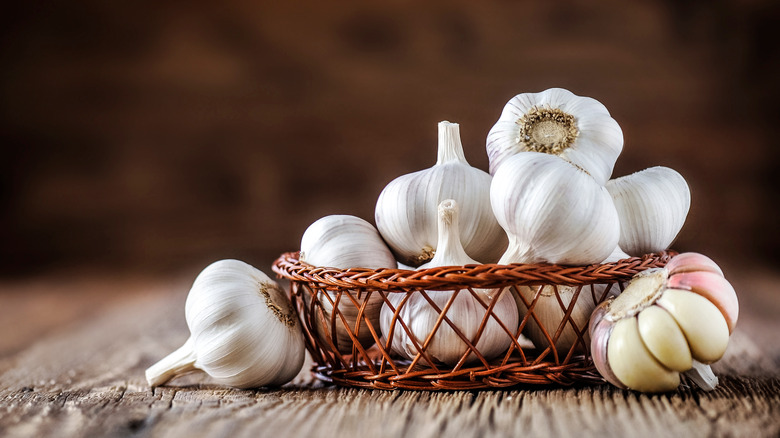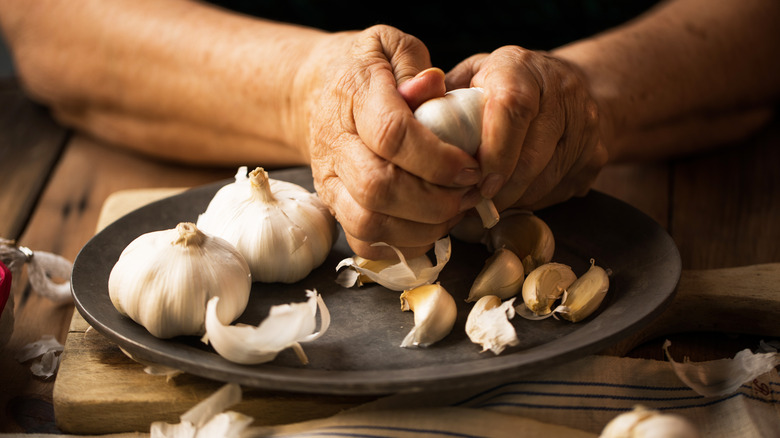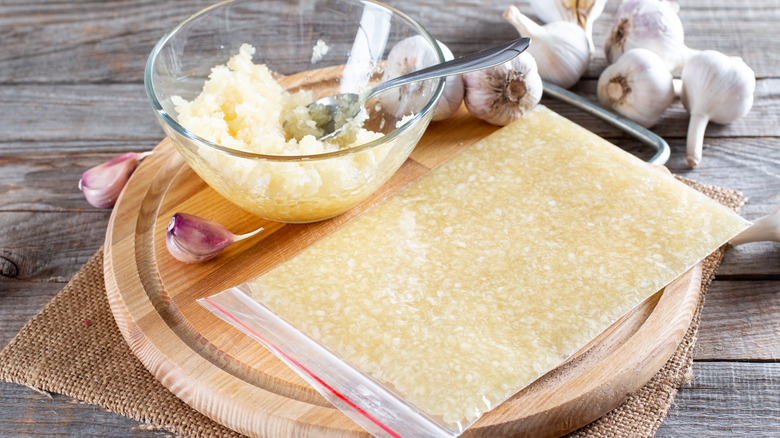Please - Don't Store Your Garlic Cloves In The Fridge
The evolutionary strategy employed by alliums like garlic to deter potential eaters — a pungent odor — seems to have backfired because we can't get enough of it. Any kitchen worth its salt will have a few bulbs tucked away because there really isn't any substitute for garlic when a recipe calls for it. The good news is that whole bulbs of garlic can stay potent for months when stored correctly — in a dry, well-ventilated spot away from sunlight.
What's interesting about storing garlic is that putting it in the fridge will make it grow and sprout faster, making it one of the many foods that don't need to be refrigerated. This is because garlic is a cold-weather crop. Even loose cloves or a bulb missing a few is best left out in ambient air to maintain its cure. Only once it's peeled and cut should the allium be stored in an airtight container in the fridge or freezer.
Since freshly peeled garlic is always the best, here's how to store and use those lovely bulbs to get the most flavor and aroma. And for the times when there's just too much to use up, peeled or otherwise, there are some nifty ways to store garlic so you can consume it at your convenience and always have some garlicky goodness around for when you crave it.
Store garlic bulbs and unpeeled cloves at room temperature
When garlic bulbs are firm and at their prime, they can remain good to eat for up to six months. Unpeeled cloves, however, will last for a few weeks. To store either, skip the plastic bag and use a container that easily lets air pass through — like a mesh basket — and keep it in a dry spot away from sunlight. Even the countertop is fine if it satisfies those criteria. While the ideal temperature to store garlic is about 65 degrees Fahrenheit, those bulbs will be fine even if it gets a little warmer or cooler.
Since loose cloves have a shorter shelf life, try using them before breaking into a fresh bulb. Similarly, bulbs with a few cloves missing tend to age much faster, so get to them sooner rather than later. If you notice green sprouts coming out the end of a clove, chop off that part and use the rest.
If you have several fresh garlic bulbs or cloves you want to store for an extended period; you may still be better off keeping them at room temperature rather than freezing them. While peeled garlic should be frozen, cloves that still have their skin can become difficult to peel once frozen. Once the garlic is peeled, however, the situation changes drastically. Those potent cloves must be used or placed in an airtight container and refrigerated quickly.
Peeled garlic is the exception that needs refrigeration
Depending on the quantity of garlic you have on hand and what you plan to do with it, you have three options: refrigeration, freezing, or pickling. To refrigerate, store peeled or chopped garlic cloves in an airtight container for up to two days. This ensures the container is completely sealed to avoid everything else in your fridge smelling like garlic.
Frozen garlic can last up to 12 months and be used for cooking straight out of the freezer. So, if you enjoy making quick meals, having chopped or minced garlic on hand can become your new favorite cooking hack. Though not as potent as fresh garlic, the garlic you have frozen yourself is still likely to taste better than pre-peeled or jarred garlic from the supermarket. Cloves or chopped garlic can be frozen in a sealed freezer-safe bag. Since it will stick together once frozen, flatten the bag so that all the garlic is in a thin layer. This makes it easier to break off the amount you need.
Pickling leftover garlic in vinegar is also an excellent way to access its bright pungency quickly. Though once pickled it's better on an appetizer plate or worked into toppings, it can still bring a punchy flavor into dishes where vinegar is also welcome. Garlic can be stored like this for up to three months if pickled correctly and refrigerated.


